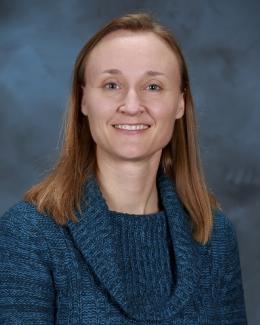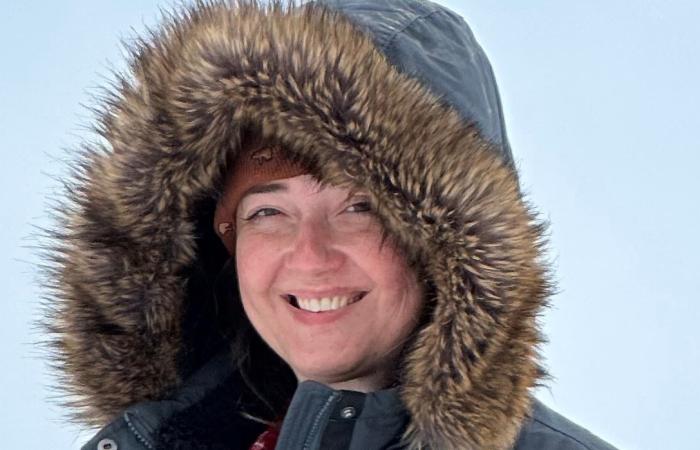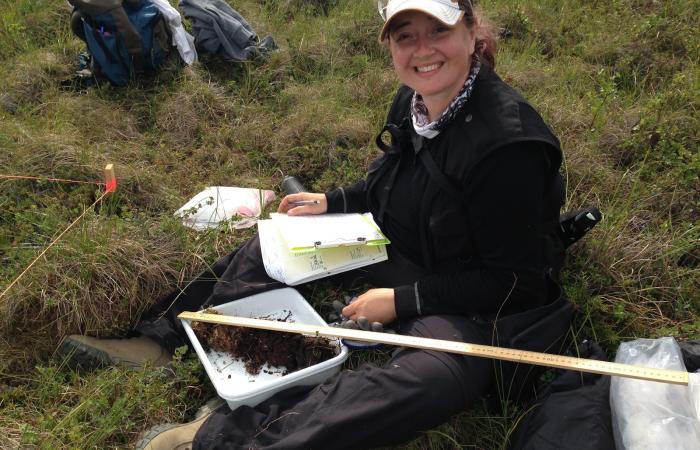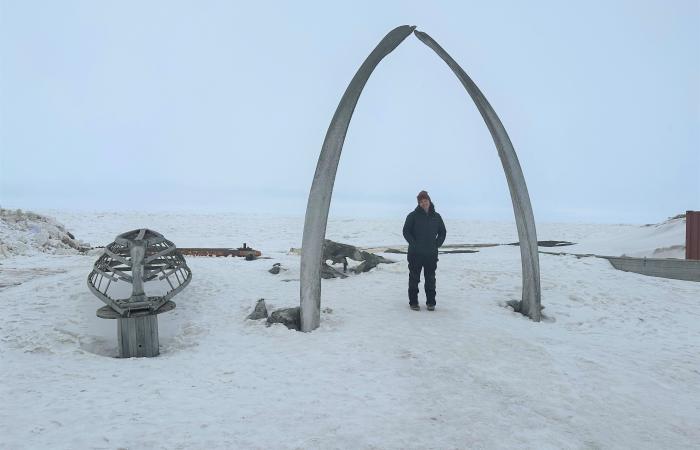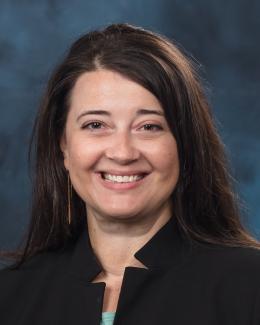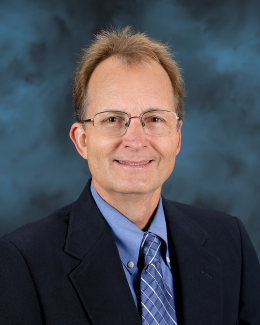Colleen Iversen, ecosystem ecologist, group leader and distinguished staff scientist at Oak Ridge National Laboratory, has been named director of the Department of Energy’s Next-Generation Ecosystem Experiments Arctic, or NGEE Arctic, a multi-institutional project studying permafrost thaw and other climate-related processes in Alaska.
Iversen has worked as a scientist on NGEE Arctic since 2012 and served as its deputy director from 2021-2023. She also leads a research team in the Plant-Soil Interactions Group at ORNL. Iversen succeeds Stan Wullschleger, founding director of NGEE Arctic, who retired as associate laboratory director for Biological and Environmental Systems Science at ORNL in April 2023.
Iversen, who took on the role of director and principal investigator for NGEE Arctic earlier this year, is excited about taking the reins of such a large, multidisciplinary project.
“I love everything about being the director of NGEE Arctic,” Iversen said. “I love the opportunity to do big science in an important part of the world, I love cross-disciplinary research and I love developing a shared, global vision with a big team — all of the things that national laboratories are very good at.”
The Arctic permafrost serves as an enormous carbon vault, and the region’s biome is warming at a pace three to four times faster than the rest of the world due to climate change and carbon feedbacks. Degradation of the permafrost and extreme events such as increasingly frequent wildfires trigger topographic changes that influence vegetation, hydrology and biogeochemical processes critical to carbon cycling and storage.
NGEE Arctic scientists gather crucial observational data and conduct experiments around these processes on the treeless Arctic tundra and then use that new understanding to inform, test or evaluate the representation of tundra in the virtual world of the land surface component of DOE’s Energy Exascale Earth System Model. E3SM integrates scientific information into global simulations run on the world’s fastest supercomputers at DOE national laboratories to better understand and predict long-term environmental change, including at the top of the world.
With the involvement of hundreds of scientists, NGEE Arctic has vastly improved predictions of climate-related processes in the sensitive Arctic tundra over the past 11 years. The project is led by ORNL and supported by the DOE Office of Science’s Biological and Environmental Research program. Major partners include the University of Alaska Fairbanks, Lawrence Berkeley National Laboratory, Los Alamos National Laboratory and Brookhaven National Laboratory.
“The NGEE Arctic director position requires scientific depth and breadth as well as the ability to manage a large group of people across different organizations. Colleen is a leader in all of these areas,” Wullschleger said. “She understands the science and that the work is accomplished in a multidisciplinary manner in which people feel respected and valued. I can't imagine anyone doing both of those any better than Colleen.”
“I’m excited for Colleen to lead this outstanding team as they continue their groundbreaking work to understand the evolution of Arctic permafrost and high-latitude carbon feedbacks,” said Dan Stover, Environmental System Sciences program manager in DOE’s BER program. “She’s an accomplished scientist and mentor who’s dedicated to advancing diversity, equity and inclusion within the NGEE team and the Arctic research communities that they work with.”
Success in a ‘daunting’ landscape
Before NGEE Arctic formally launched in 2012, Wullschleger recalls traveling to the tundra and discussing with colleagues how foreign and daunting the remote landscape seemed. “We felt the weight of our responsibility to try and bring the sophistication of the national laboratories to these remote locations, and to represent not only our individual organizations, but the Department of Energy in terms of science, modeling and technology.”
“After the first few years of the project, we realized we were doing just that,” he said. “We understood the scientific challenges and rose to meet them, we kept our people safe, and we raised the bar for the project every year, including in our interactions with Indigenous communities. It was pretty satisfying coming to that realization.”
The project began with field work in the North Slope region of Alaska near the town of Utqiaġvik, some 330 miles north of the Arctic Circle and underlain by continuous permafrost. Research later extended south and westward to the discontinuous permafrost landscape of the Seward Peninsula.
“There was a lot of discussion that went on about the scope of our work on lands owned by the Native Peoples of Alaska. One of the most rewarding moments was sitting around a table with 10 Iñupiat Elders of a Native corporation and relaying to them what you promise to do on their lands, and how you will return the lands to them,” Wullschleger said. “Their response was ‘Yes. We will shake hands, and this will be done.’ I said, ‘Well, there might be some paperwork, too.’ But a lot of that was sealed in a handshake.”
Going global while eyeing the Pan-Arctic
The team is excited to have the opportunity to propose a next phase of the project to take NGEE Arctic’s modeling approach “on the road,” in a cyber sense, to other regions of the Arctic around the world, known as the Pan-Arctic. Since its inception, the project has had an observational focus that supported modeling across scales from plots to regions to the entire state of Alaska. The scientists now hope to take their improved model to other countries where similar observations and measurements have been collected to see how well the model does at accurately simulating different types of tundra across various climate and vegetation regions of the Pan-Arctic.
“The tundra is extremely variable across the eight Arctic countries, and we want to take what we learned in Alaska to simulate as much of the remaining Arctic region as we can,” Iversen said. NGEE Arctic scientists propose gathering available information from as many as 10-15 collaborative sites across the Pan-Arctic to see how well its model can predict carbon, nutrient and water fluxes under current conditions and in response to expected future climate change.
Iversen said she is looking forward to setting both the scientific and the cultural vision for NGEE Arctic. Safety and inclusion have been foundational to the project — not just physical safety, but the psychological safety of a respectful, harassment-free environment, she said. “That intentional focus on our values will continue. It’s not just about what we do, but how we do it.”
She enjoys thinking about what comes next for the project, including who will be involved. “We’re continuing NGEE Arctic’s focus on mentoring. I recently asked to add a rising leader from each partner institution to our planning discussions. These early career scientists have great ideas and can benefit from the experience of working together on a very large, cross-disciplinary team,” Iversen said.
Many scientists have cycled in and out of the project over the years and distinguished themselves with their research, Wullschleger said. An emphasis of the project has been to support early and mid-career scientists in particular. “That is one of the legacies of the Department of Energy with this long-term science project. You get to welcome a whole new generation of scientists to the table.”
In addition to DOE support, NGEE Arctic acknowledges UIC Science, the Bering Straits Native Corporation, the Council Native Corporation, Mary’s Igloo Native Corporation and the Sitnasuak Native Corporation for their guidance and for allowing scientists to conduct research on the traditional homelands of the Iñupiat.
UT-Battelle manages ORNL for the Department of Energy’s Office of Science, the single largest supporter of basic research in the physical sciences in the United States. The Office of Science is working to address some of the most pressing challenges of our time. For more information, please visit energy.gov/science. — Stephanie Seay
